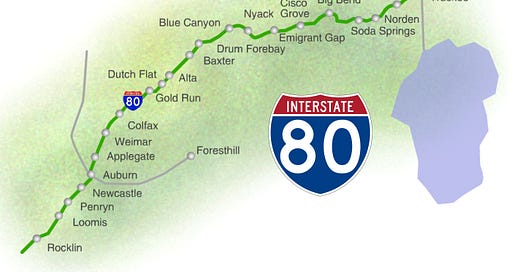Written by Gary Noy
Interstate 80 passes through the remnants of an old hydraulic mining area at this point.
In the late 1850s, hydraulic mining – the practice of washing away hillsides with powerful jets of water to recover the hidden gold – was commonly done throughout the region. During this period, a Massachusetts miner by the name of Orrin Whitcomb Hollenbeck established a small mining and commercial operation. Hollenbeck constructed a hotel and entered the town-building business. He called his settlement Mountain Springs. In 1862, a post-office was set up and Hollenbeck was named postmaster. While the location was still commonly called Mountain Springs, the town received the official designation of Gold Run in 1863.
The construction of the Central Pacific Railroad and the development of the Gold Run mines increased the town’s business, and Hollenbeck became prosperous. Hollenbeck was active in Republican Party politics and, in 1867; he was elected Placer County Treasurer.
Gold Run prospered as well. More than $6 million in gold was recovered from the hydraulic mines in the region during the years 1865–1878. The population exceeded 400 in the late 1860s, making it one of the largest cities in Placer County.
As hydraulic mining became restricted in the 1870s and 1880s, Gold Run withered. The population disappeared and only a handful of buildings remain in the location of the once booming town.
Today, Gold Run is best known for its roadside rest areas.
From the series “On the Road: Interstate 80 from Rocklin to Truckee” – historical descriptions of twenty-three stops along the way
Number 11 of 23




